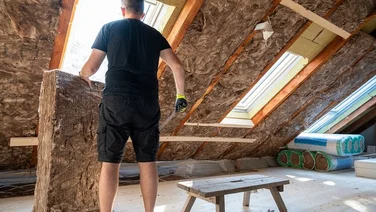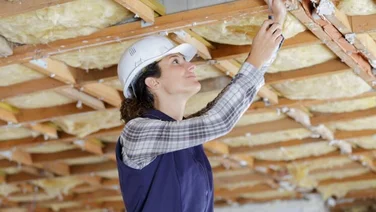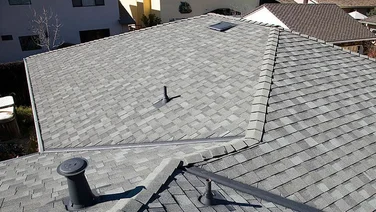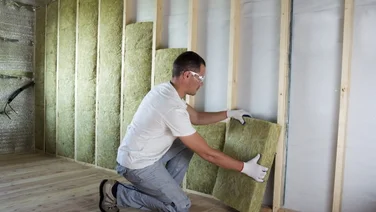- Spray foam insulation is very effective at keeping heat inside your loft, but it’s also expensive
- Loose fill and blanket insulation are good for lofts with suspended floors
- Blown fibre insulation is a more eco-friendly alternative to spray foam
- There are grants available if you don’t think you can afford loft insulation
Insulating a loft can be expensive, with the cost of spray foam insulation often going over £1,000. Luckily, it’s not the only option.
In this article, we’ll explain what the five best types of loft insulation are. We’ll assess their pros and cons, and tell you how much each of them costs.
If you’re considering loft insulation, you can find the best deals by simply popping a few details in this quick form.
Once you do that, we can put you in touch with spray foam insulation installers. They’ll reach out to you with offers.
Get free insulation quotes
Answer a few quick questions, and our trusted installers will send you bespoke insulation quotes – for free.

What is the best type of loft insulation?
The ‘best’ type is the one that meets your specific needs, and that will depend on the size of your property, the space you’re looking to insulate and what you can afford.
There are plenty of ones to choose from, and finding the option that’s right for you depends on your budget, the layout of your loft, and your personal preferences.
The five best types of loft insulation are:
- Spray foam insulation
- Blown fibre insulation
- Blanket insulation
- Loose fill insulation
- Sheet insulation
Spray foam, blown fibre, and sheet insulation are all applied to the inner roof of the loft, whilst blanket and loose fill insulation are installed in the floor.
To understand how much loft insulations costs, and for a full breakdown of loft insulation costs, go to our page.
Spray foam insulation
Spray foam insulation is made from polyurethane, a synthetic material. It’s typically sprayed in the form of foam on the inner roof of a loft, between the beams.
There are two types of spray foam: closed-cell foam and open-cell foam. Closed-cell foam is more dense than open-cell foam, and expands then hardens after it’s applied.
Open-cell foam is less dense than closed-cell foam. It doesn’t expand as much when it’s applied and has a spongy texture when dry.
The main advantage of spray foam insulation is that it’s highly effective at keeping heat inside the loft – more so than other types of insulation.
On the downside, its airtight structure can sometimes lead to issues with damp, which has made some mortgage lenders refuse to lend money to homes that have spray foam.
Spray foam insulation costs around £20 to £50 per square metre, making it one of the more expensive types of insulation.
Pros and cons of spray foam insulation
- More effective at keeping heat in than other types of insulation
- Flexible, can be applied in difficult to reach areas
- Lasts up to 80 years
- One of the most expensive insulation types
- Can cause issues with damp
- Some mortgage lenders won’t lend to homes with spray foam insulation
Blown fibre insulation
Blown fibre insulation, also called blown-in insulation, is similar to spray foam insulation in the sense that it’s sprayed onto the inner roof of a loft. What’s different are the materials it’s made of.
The main types of materials used for blown fibre insulation are fibreglass (recycled glass particles), mineral wool (stone or glass particles), and cellulose (paper fibres).
Fibreglass is typically the preferred material when it comes to blown fibre insulation since it’s less prone to mould growth.
Blown fibre is generally a little cheaper than spray foam insulation, costing £6 to £50 depending on the material. It’s made from natural materials, so it also has the advantage of being more eco-friendly than synthetic spray foam.
Pros and cons of blown fibre insulation
- Eco-friendly options available
- Flexible, can be applied in difficult to reach areas
- One of the most effective types of insulation
- Certain materials can be prone to mould
- One of the more expensive types of insulation
- Messy to install since fibre particles can cause dust when being applied

Blanket insulation
Blanket insulation is a type of floor insulation that’s very easy to install in a loft. It typically comes in thick rolls or sheets, made from materials such as fibreglass, mineral wool, plastic fibres, or sheep’s wool.
Installing it involves placing the insulating rolls between the floor joists (the beams in the floor) and securing everything with netting.
It costs around £5 per square metres, making it one of the cheapest types of insulation.
The main downside to blanket insulation is that it’s not as effective as other types of insulation. You might need to lay several sheets of material, depending on how much heat you’re trying to save.
Pros and cons of blanket insulation
- One of the cheapest forms of insulation
- Easy to install, can be a DIY project
- Not as good at retaining heat as other forms of insulation
- Takes up a lot of space, and not all loft floors are suitable for it
Loose fill insulation
Loose fill insulation consists of loose granules, which can be made from cork, mineral wool, or cellulose fibre. These granules are poured in between the floor joists, and can be used on their own, or in addition to existing insulation.
The advantage of loose fill insulation is that it’s relatively cheap – it costs around £20 to £30 per square metre – and easy to install.
The downside is it can compress over time, which will reduce its thermal resistance. When that happens, you’ll start to lose heat.
It can also be prone to absorbing water, which can cause damp and mould. This is why it’s important to get loose fill insulation that’s been treated with anti-mould solutions.
Pros and cons of loose fill insulation
- Relatively inexpensive
- Easy to install
- Can fit into tight, hard to access spaces
- Can make a mess when being installed
- Compresses over time and loses thermal resistance
- Can be prone to absorb water and cause mould
Sheet insulation
Sheet insulation comes in the form of rigid sheets or boards, which can be made of synthetic materials such as polystyrene, or natural materials like mineral wool.
These sheets are stuck to the inner roof of the loft with a flexible sealant.
It cost around £35 per square metre, making it one of the pricier types of loft insulation.
One advantage of sheet insulation is that the sheets can be cut to size, so they fit into all the nooks and bends of the loft roof.
However, doing this correctly can be tricky, and requires a professional.
Sheet insulation is also good at controlling moisture, and sheets made from expanded polystyrene can act as a vapour barrier, stopping moisture from entering the home.
Pros and cons of sheet insulation
- Can be cut to fit unique roof shapes
- Good at controlling moisture
- On the expensive side
- Requires a professional in order to be properly fitted
How thick should my loft insulation be?
This will depend on your property and the size of the space you’re trying to insulate.
However, the recommended thickness of insulation in a loft is 270 millimetres (mm) for optimal results, although insulation that’s 200 mm thick will still make a big difference.
Ultimately, any insulation is better than none, and whichever one you choose, you will benefit.
Do I need to take my old insulation off before I start?
No, if your old insulation is in good condition, there’s no need to to remove it.
However, before you start laying your new insulation on top, check for mould, pests and/or any old smells.
If you notice any of these, it’s best to get your old insulation removed by a professional as mould and damp can spread to the rest of your property.
Another thing to consider is where you lay your new insulation. Make sure you keep it clear of any light fixtures or electrical wires in your loft as this can create a fire hazard.
It’s also important to not block any vents with your insulation – they’re there for a reason, after all.
Which type of loft insulation should I choose?
To answer this question, think about what you’re looking for and what you can afford.
If your main concern is having a very tightly insulated loft, then spray foam insulation or blown fibre insulation are the best options, since they’re the best at stopping heat from escaping.
However, they’re also expensive, and if your budget is limited, you might prefer a cheaper option, such as blanket insulation or loose fill insulation.
Both are still great at keeping heat in, even if they don’t create quite as tight of a seal as other insulation types.
If your loft doesn’t have suspended floors, then blanket insulation or loose fill won’t be possible to install, even if you wanted them.
However that doesn’t mean you have to fork out more money than you’d like on blown fibre insulation. Sheet insulation – which goes on the inner roof – is a reasonably priced and effective alternative.
If you’re worried about the costs, it could be that you are eligible for a loft insulation grant. Take a look at our page to see if a loft insulation grant could help you.
Summary
- Insulating your loft is a great way to preserve heat in your home and keep your energy bills down.
- A quarter of all household heat is lost through the roof in uninsulated homes, according to the Energy Saving Trust.
- Spray foam is the most efficient type of insulation when it comes to keeping heat inside your loft.
- You could be eligible for a grant to help you with the costs of loft insulation.
- If you want to get a quote for insulation, just fill in our form. We’ll pass your details onto professional installers, who’ll reach out to you with their best prices.







